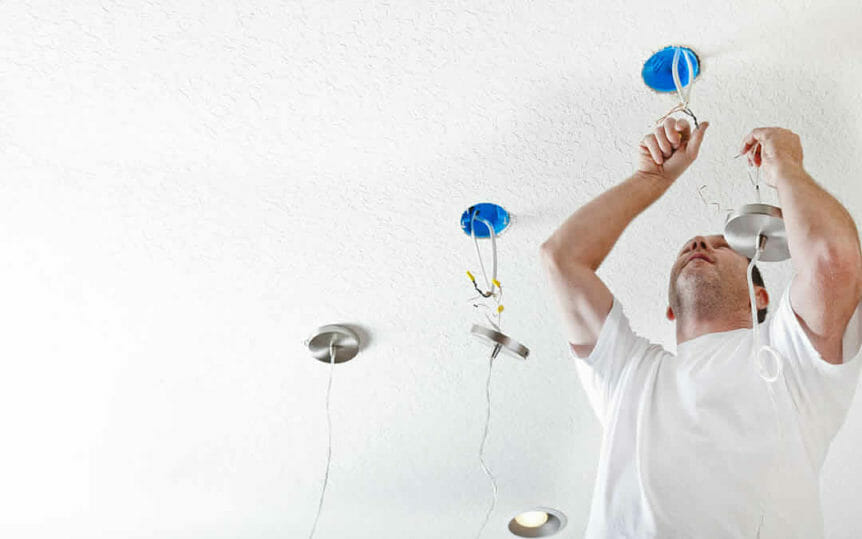
Home Lighting Rules 101
Nothing draws attention to a room like a chandelier or a statement light. Lighting has the ability to turn a drab living room into a showpiece, and can make eating at your dining room table a romantic event. Are you ready for some upgrades to your home? Lighting can be a relatively inexpensive way to make a big change. Purchasing the fixture or vanity is the easy part, but the installation process can be tricky.
When it comes to replacing or adding new lighting, it is important to do it by the book. Many times, homeowners think they can install an overhead light themselves, and when they are finished noticed a few extra parts still in the box. Does this sound familiar? The fact is, lighting installation is not easy, and if not done correctly can end up causing a whole lot of problems.
“A lot of the calls we get for a lighting installation comes after the customer has tried to install the light without professional help,” said John Moore Services Electrical Manager David Floyd. “And what we run into a lot when putting in new fixtures is when we take the existing fixture out, we find that it wasn’t installed correctly in the first place. It doesn’t have correct wiring, or doesn’t have proper J-box bracing. And taking a shortcut isn’t what you want to do with lighting.”
Houston Lighting Installation Rules
Make sure the new fixture meets weight requirements. A lot of homeowners end up replacing builder-grade fixtures throughout their home with nicer fixtures. But typically, the nicer the fixture, the heavier it will be.
“Chandeliers, decorative fans, and vanity fixtures can be excessively heavy because of the glass and other decorative items that are added on,” said Floyd. “A simple vanity is heavy already, but to top it off with pounds of decorative glass adds a lot of extra weight. So before anything can be installed, you need to make sure the J-box is properly installed and mounted so that wall can handle the extra weight.”
To clarify, a J-box, or junction box, is a box attached to lighting fixtures that encloses all its wiring. It has plastic tabs inside that allow wires to go through. This helps protect the wires and, if there is a heat condition, can help delay a fire.
Make sure all fixtures are grounded. All fixtures, no matter how big or small, need to be properly grounded. Each individual metal piece on the fixture needs to be grounded, and most all fixtures will come with a ground in them. And all grounding needs to be tied to a metal mounting bracket. If the fixture is not grounded, you are opening yourself up to the possibility of being shocked each time you turn on the light.
Make sure the fixture is wired properly. Fans and chandeliers are challenging to install because they come with a lot of wires and parts that must be installed correctly.
“Trying to install a fan/light combo is difficult because all the wiring has to correctly fit inside the J-box, and that is not easy to do,” said Floyd. “The biggest thing about wiring is the connections; if you don’t make proper connections it might still work, but it is not working correctly. Improper connections create heat conditions and can lead to a fire.”
Make sure your lighting is up to code. A common spot for people to upgrade lighting or install new lighting is in the closet. Years ago it was common to see a light bulb with a string as the light source for a closet, and some older homes still have it. But that particular style has been outlawed because it would often shatter or create a heat condition.
“Today’s code states that any light inside a closet has to be enclosed and protected. If you accidently bump items against the light it will be less likely to break and if items in the closet brush up against it, it will be less likely to create heat conditions and start a fire,” said Floyd.
Make sure to check ratings on all fixtures. Before installing any type of lighting, it is important to check the box and see if the fixture is rated for the inside or outside. A lot of people hang fixtures outside that are made for indoor use only. This creates a lot of issues with the fixture itself and can become a fire hazard.
Also check the instructions to see what wattage the fixture is rated for. Using a higher wattage bulb than the fixture specifies can cause heat conditions and potentially start a fire.
As you can see, there are many things to keep in mind when installing lighting, and this is why we recommend hiring a professional. By using a licensed electrician at John Moore Services you are giving yourself the advantage of warranties, guarantees, and expertise. Next time you want to change the lighting in your home, give yourself a break and call the experts.
